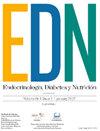Real-world evaluation of the efficacy and safety of switching from weekly dulaglutide to weekly semaglutide: The SEMA-SWITCH study
IF 1.8
4区 医学
Q4 ENDOCRINOLOGY & METABOLISM
引用次数: 0
Abstract
Introduction
Dulaglutide and semaglutide are once-weekly administered GLP-1 receptor agonists (GLP-1 RAs) indicated for the treatment of hyperglycemia in individuals with type 2 diabetes mellitus (T2DM) and obesity (BMI ≥ 30 kg/m2).
Objective
To evaluate the efficacy and safety of switching from subcutaneous (SC) dulaglutide to SC semaglutide, in real-world conditions.
Materials and methods
A total of 123 individuals with T2DM on SC dulaglutide, either as monotherapy or with other antihyperglycemic drugs, who switched to SC semaglutide were included. This switch was motivated by insufficient reduction in glycated hemoglobin (HbA1C), the need for greater weight loss, or gastrointestinal intolerance associated with dulaglutide. Changes with semaglutide in HbA1C and weight at 6, 12, 18, and 24 mo, as well as any changes in associated adverse effects. Data are expressed as mean ± standard deviation.
Results
Previous treatment with dulaglutide (duration 16.9 ± 13.8 mo) reduced HbA1c by 0.38% (p = 0.003 vs. baseline) and weight by −1.3 kg (p = 0.003 vs. baseline). After switching to semaglutide, an additional reduction in HbA1C levels was observed at 6, 12, 18, and 24 mo (−0.43%, p = 0.000; −0.54%, p = 0.000; −0.38%, p = 0.021; −0.12%, p = 0.622, respectively) and in weight at 6, 12, 18, and 24 mo (−2.7 kg, p = 0.000; −3.7 kg, p = 0.000; −5.4 kg, p = 0.001; −4.2 kg, p = 0.000, respectively) With no significant differences in the frequency of adverse effects after switching to semaglutide.
Conclusions
In real-world conditions, switching dulaglutide to semaglutide in obese patients with T2DM is associated with an additional reduction in HbA1C and weight, without notable changes in the frequency of adverse effects.
从每周一次的杜拉鲁肽转换为每周一次的西马鲁肽的有效性和安全性的实际评估:SEMA-SWITCH研究。
Dulaglutide和semaglutide是每周一次的GLP-1受体激动剂(GLP-1 RAs),用于治疗2型糖尿病(T2DM)和肥胖(BMI ≥ 30 kg/m2)患者的高血糖。目的:评价在现实条件下,从皮下(SC)杜拉鲁肽转换为皮下(SC) semaglutide的有效性和安全性。材料和方法:共有123例T2DM患者接受SC西马鲁肽单药治疗或与其他降糖药物联合治疗,转而使用SC西马鲁肽。这种转变的动机是糖化血红蛋白(HbA1C)降低不足,需要更大程度的减肥,或杜拉鲁肽相关的胃肠道不耐受。在6、12、18和24 mo时使用西马鲁肽的HbA1C和体重变化,以及相关不良反应的任何变化。数据表示为平均值 ± 标准差。结果:先前的dulaglutide治疗(持续时间16.9 ± 13.8 mo)使HbA1c降低0.38% (p = 0.003与基线相比),体重降低-1.3 kg (p = 0.003与基线相比)。改用semaglutide后,在6、12、18和24个月时观察到HbA1C水平的进一步降低 mo (-0.43%, p = 0.000;-0.54%, p = 0.000;-0.38%, p = 0.021;-0.12%, p = 0.622),体重在6、12、18和24 月(-2.7 kg, p = 0.000; 公斤-3.7,p = 0.000; 公斤-5.4,p = 0.001;-4.2 kg, p = 0.000)改用西马鲁肽后不良反应发生频率无显著差异。结论:在现实条件下,肥胖T2DM患者将dulaglutide转换为semaglutide与HbA1C和体重的额外降低相关,而不良反应的频率没有显着变化。
本文章由计算机程序翻译,如有差异,请以英文原文为准。
求助全文
约1分钟内获得全文
求助全文
来源期刊

Endocrinologia Diabetes Y Nutricion
Multiple-
CiteScore
2.10
自引率
10.50%
发文量
99
期刊介绍:
Endocrinología, Diabetes y Nutrición is the official journal of the Spanish Society of Endocrinology and Nutrition (Sociedad Española de Endocrinología y Nutrición, SEEN) and the Spanish Society of Diabetes (Sociedad Española de Diabetes, SED), and was founded in 1954.
The aim of the journal is to improve knowledge and be a useful tool in practice for clinical and laboratory specialists, trainee physicians, researchers, and nurses interested in endocrinology, diabetes, nutrition and related disciplines.
It is an international journal published in Spanish (print and online) and English (online), covering different fields of endocrinology and metabolism, including diabetes, obesity, and nutrition disorders, as well as the most relevant research produced mainly in Spanish language territories.
The quality of the contents is ensured by a prestigious national and international board, and by a selected panel of specialists involved in a rigorous peer review. The result is that only manuscripts containing high quality research and with utmost interest for clinicians and professionals related in the field are published.
The Journal publishes Original clinical and research articles, Reviews, Special articles, Clinical Guidelines, Position Statements from both societies and Letters to the editor.
Endocrinología, Diabetes y Nutrición can be found at Science Citation Index Expanded, Medline/PubMed and SCOPUS.
 求助内容:
求助内容: 应助结果提醒方式:
应助结果提醒方式:


